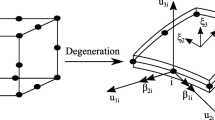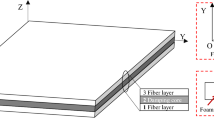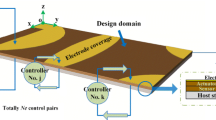Abstract
This work deals with the layout optimization of piezoelectric fiber composite patches on a vibrating laminated composite plate and the discrete material design of the composite plate. The vibration of the composite plate is excited by an external mechanical loading, and a sinusoidal voltage with given amplitude and frequency is applied on the piezoelectric fiber composite patches. The analysis of the composite structure with piezoelectric fiber composite patches is performed via a finite element method in condensed form, where the piezoelectric effects are considered as induced force. As a view to minimize the dynamic response of the vibrating laminated composite structure, the Discrete Material Optimization method is employed to perform the design optimization of piezoelectric fiber composite patches and the stacking sequence, fiber angles, and selection of material for the composite structure. Numerical examples are presented to demonstrate the effectiveness of the proposed method.






















Similar content being viewed by others
References
Allaire G, Jouveb O (2001) Eigenfrequency optimization in optimal design. Comput Meth Appl Mech Eng 190(28):3565–3579
Anton SR, Sodano HA (2007) A review of power harvesting using piezoelectric materials (2003–2006). Smart Mater Struct 16(3):R1–R21
Bendsøe MP (1989) Optimal shape design as a material distribution problem. Struct Optim 1(4):193–202
Bendsøe MP, Sigmund O (1999) Material interpolation schemes in topology optimization. Arch Appl Mech 69(9–10):635–654
Bruyneel M (2011) SFP—a new parameterization based on shape functions for optimal material selection: application to conventional composite plies. Struct Multidiscip Optim 43(1):17–27
Bruyneel M, Fleury C (2002) Composite structures optimization using sequential convex programming. Adv Eng Softw 33(7):697–711
Diaz AR, Kikuchi N (1992) Solutions to shape and topology eigenvalue optimization problems using a homogenization method. Int J Numer Methods Eng 35(7):1487–1502
Donoso A, Sigmund O (2009) Optimization of piezoelectric bimorph actuators with active damping for static and dynamic loads. Struct Multidiscip Optim 38(2):171–183
Du J, Olhoff N (2007) Topological design of freely vibrating continuum structures for maximum values of simple and multiple eigenfrequencies and frequency gaps. Struct Multidiscip Optim 34(2):91–110
Duan Z, Yan J, Zhao G (2015) Integrated optimization of the material and structure of composites based on the Heaviside penalization of discrete material model. Struct Multidiscip Optim 51(3):721–732
Frecker MI (2003) Recent advances in optimization of smart structures and actuators. J Intell Mater Syst Struct 14(4):207–216
Gao F, Shen Y, Li L (2000) The optimal design of piezoelectric actuators for plate vibroacoustic control using genetic algorithms with immune diversity. Smart Mater Struct 9(4):485–491
Gao T, Zhang WH, Duysinx P (2013) Simultaneous design of structural layout and discrete fiber orientation using bi-value coding parameterization and volume constraint. Struct Multidiscip Optim 48(6):1075–1088
Gaul DIHL, Kögl DIM, Wagner DIM (2003) Boundary element methods for engineers and scientists. Springer, Berlin Heidelberg
Jaewook L, Dongjin K, Tsuyoshi N, Dede EM, Jeonghoon Y (2018) Topology optimization for continuous and discrete orientation design of functionally graded fiber-reinforced composite structures. Compos Struct 201:217–233
Jog CS (2002) Topology design of structures subjected to periodic loading. J Sound Vib 253(3):687–709
Kang Z, Tong L (2008a) Topology optimization-based distribution design of actuation voltage in static shape control of plates. Comput Struct 86(19–20):1885–1893
Kang Z, Tong L (2008b) Integrated optimization of material layout and control voltage for piezoelectric laminated plates. J Intell Mater Syst Struct 19(8):889–904
Kiyono CY, Silva ECN, Reddy JN (2012) Design of laminated piezocomposite shell transducers with arbitrary fiber orientation using topology optimization approach. Int J Numer Methods Eng 90(12):1452–1484
Kiyono CY, Silva ECN, Reddy JN (2016a) A novel fiber optimization method based on normal distribution function with continuously varying fiber path. Compos Struct 160:503–515
Kiyono CY, Silva ECN, Reddy JN (2016b) Optimal design of laminated piezocomposite energy harvesting devices considering stress constraints. Int J Numer Methods Eng 105(12):883–914
Kögl M, Bucalem ML (2005) A family of piezoelectric MITC plate elements. Comput Struct 83(15–16):1277–1297
Kögl M, Silva ECN (2005) Topology optimization of smart structures: design of piezoelectric plate and shell actuators. Smart Mater Struct 14(2):387–399
Lund E (2009) Buckling topology optimization of laminated multi-material composite shell structures. Compos Struct 91(2):158–167
Lund E, Stegmann J (2006) Eigenfrequency and buckling optimization of laminated composite shell structures using discrete material optimization. Bendsøe MP, Olhoff N, Sigmund O (eds) IUTAM symposium on topological design optimization of structures, machines and materials, Springer, Dordrecht, Netherlands
Nelli Silva EC, Nishiwaki S, Kikuchi N (1999) Design of piezocomposite materials and piezoelectric transducers using topology optimization. Part III. Arch Comput Meth Eng 6(4):305–329
Niu B, Olhoff N, Lund E, Cheng G (2010) Discrete material optimization of vibrating laminated composite plates for minimum sound radiation. Int J Solids Struct 47(16):2097–2114
Niu B, He X, Shan Y, Yang R (2018) On objective functions of minimizing the vibration response of continuum structures subjected to external harmonic excitation. Struct Multidiscip Optim 57(6):2291–2307
Olhoff N (1976) Optimization of vibrating beams with respect to higher order natural frequencies. J Struct Mech 4(1):87–122
Olhoff N (1977) Maximizing higher order Eigenfrequencies of beams with constraints on the design geometry. Mech Base Des Struct Mach 5(2):107–134
Olhoff N, Du J (2014) In: Rozvany G, Lewiński T (eds) Topological design for minimum dynamic compliance of structures under forced vibration. Topology optimization in structural and continuum mechanics. Springer, Heidelberg
Olhoff N, Niu B, Cheng G (2012) Optimum design of band-gap beam structures. Int J Solid Struct 49(22):3158–3169
Padoin E, Santos IF, Perondi EA, Menuzzi O, Gonçalves JF (2018) Topology optimization of piezoelectric macro-fiber composite patches on laminated plates for vibration suppression. Struct Multidiscip Optim
Qing HQ (2012) Advanced mechanics of piezoelectricity. Higher Education Press, Beijing
Quek ST, Wang SY, Ang KK (2003) Vibration control of composite plates via optimal placement of piezoelectric patches. J Intell Mater Syst Struct 14(4):229–245
Qureshi EM, Shen X, Chen JJ (2014) Vibration control laws via shunted piezoelectric transducers: a review. Int J Aeronaut Space Sci 15(1):1–19
Ray MC, Reddy JN (2013) Active damping of laminated cylindrical shells conveying fluid using 1–3 piezoelectric composites. Compos Struct 98:261–271
Rozvany GIN, Zhou M, Birker T (1992) Generalized shape optimization without homogenization. Struct Optim 4(3–4):250–252
Ruiz D, Díaz-Molina A, Sigmund O, Donoso A, Bellido JC, Sánchez-Rojas JL (2018) Optimal design of robust piezoelectric unimorph microgrippers. Appl Math Model 55:1–12
Salas RA, Ramírez-Gil Fran FJ, Montealegre-Rubio W, Silva ECN, Reddy JN (2018) Optimized dynamic design of laminated piezocomposite multi-entry actuators considering fiber orientation. Comput Methods Appl Mech Eng 335:223–254
Sigmund O, Jensen JS (2003) Systematic design of phononic band-gap materials and structures by topology optimization. Philos Trans 361(1806):1001–1019
Silva ECN, Kikuchi N (1999) Design of piezocomposite materials and piezoelectric transducers using topology optimization—part III. Arch Comput Meth Eng 6(4):305–329
Sørensen SN, Lund E (2013) Topology and thickness optimization of laminated composites including manufacturing constraints. Struct Multidiscip Optim 48(2):249–265
Sørensen R, Lund E (2015a) Thickness filters for gradient based multi-material and thickness optimization of laminated composite structures. Struct Multidiscip Optim 52(2):227–250
Sørensen R, Lund E (2015b) In-plane material filters for the discrete material optimization method. Struct Multidiscip Optim 52(4):645–661
Stegmann J, Lund E (2005) Discrete material optimization of general composite shell structures. Int J Numer Methods Eng 62(14):2009–2027
Sun HL, Chen HB, Zhang K, Zhang PQ (2008) Research on performance indices of vibration isolation system. Appl Acoust 69(9):789–795
Sun H, Yang ZC, Li KX, Li B, Xie J, Wu D, Zhang LL (2009) Vibration suppression of a hard disk driver actuator arm using piezoelectric shunt damping with a topology-optimized PZT transducer. Smart Mater Struct 18(6):065010
Svanberg K (1987) The method of moving asymptotes—a new method for structural optimization. Int J Numer Methods Eng 24(2):359–373
Tzou HS, Tseng CI (1990) Distributed piezoelectric sensor/actuator design for dynamic measurement/control of distributed parameter systems: a piezoelectric finite element approach. J Sound Vib 138(1):17–34
Vatanabe SL, Paulino GH, Silva ECN (2013) Design of functionally graded piezocomposites using topology optimization and homogenization—toward effective energy harvesting materials. Comput Methods Appl Mech Eng 266:205–218
Wang J, Mak CM (2013) An indicator for the assessment of isolation performance of transient vibration. J Vib Control 19(16):2459–2468
Wang SY, Tai K, Quek ST (2006) Topology optimization of piezoelectric sensors/actuators for torsional vibration control of composite plates. Smart Mater Struct 15(15):253
Xia Q, Shi T (2018) A cascadic multilevel optimization algorithm for the design of composite structures with curvilinear fiber based on Shepard interpolation. Compos Struct 188:209–219
Zhang X, Kang Z (2014) Topology optimization of piezoelectric layers in plates with active vibration control. J Intell Mater Syst Struct 25(6):697–712
Zhang X, Kang Z, Li M (2014) Topology optimization of electrode coverage of piezoelectric thin-walled structures with CGVF control for minimizing sound radiation. Struct Multidiscip Optim 50(5):799–814
Zheng B, Chang CJ, Gea HC (2009) Topology optimization of energy harvesting devices using piezoelectric materials. Struct Multidiscip Optim 38(1):17–23
Funding
This work is partially supported by the National Natural Science Foundation of China (NSFC Nos. 51975087, 51790172, 51505064, 51675082), Natural Science Foundation of Liaoning Province (no. 2015020154), and Fundamental Research Funds for the Central Universities (DUT17ZD207). These supports are gratefully appreciated.
Author information
Authors and Affiliations
Corresponding author
Ethics declarations
Conflict of interest
The authors declare that they have no conflict of interest.
Additional information
Responsible Editor: Helder C. Rodrigues
Publisher’s note
Springer Nature remains neutral with regard to jurisdictional claims in published maps and institutional affiliations.
Rights and permissions
About this article
Cite this article
Niu, B., Shan, Y. & Lund, E. Discrete material optimization of vibrating composite plate and attached piezoelectric fiber composite patch. Struct Multidisc Optim 60, 1759–1782 (2019). https://doi.org/10.1007/s00158-019-02359-8
Received:
Revised:
Accepted:
Published:
Issue Date:
DOI: https://doi.org/10.1007/s00158-019-02359-8




